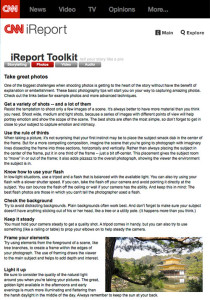Insight: News Organizations Make Limited Use of Citizen Photography
2 Missouri Journalism Researchers Examine the Participatory Nature of Visual Journalism

Columbia, Mo. (May 28, 2015) — Replacing the work of staff photographers with citizen-generated pictures has been a concern for photojournalists, but research at the Missouri School of Journalism indicates news organizations’ use of citizen photographs may be restricted to specific types of events or circumstances.
Keith Greenwood, associate professor, and Ryan Thomas, assistant professor, of the Missouri School of Journalism, examined the incorporation of citizen-created photographs from the Ferguson demonstrations in August 2014 and more generally as part of the online presence of different news organizations.
“Most of the academic literature and popular debate around citizen photojournalism has focused on issues of perception and attitude,” Greenwood said. “This means we know quite a bit about what citizen and professional photojournalists think about each other, but not a lot about the actual content of citizen photojournalism – how and when it is incorporated into news coverage.”

The study examined online photographic coverage of Ferguson events in the St. Louis Post-Dispatch, the Columbia Missourian and the Chicago Sun-Times. Ferguson was a local story for the Post-Dispatch, increasing the likelihood that citizen photographs would have local interest. The story was a regional one for the Missourian, which, as part of its connection to the Missouri School of Journalism, has the potential to be innovative with coverage. The story also was a regional one for the Sun-Times, which had previously laid off its entire professional photography staff, relying instead on photographs submitted by reporters and citizens.
The study found limited evidence of the incorporation of user-generated content in coverage by the newspapers. Rather, news organizations used a combination of photographs shot by staff photographers and wire service images and supplemented these images with citizen-shot images and video on a very sporadic basis, often drawn from social media.
The study also looked more broadly at how some news organizations incorporate citizen photography on an ongoing basis, looking at published content on the Missourian’s “From readers” section and the CNN iReport page, which was established for the purpose of presenting user-generated content. The national, television-oriented channel provides a contrast to the more local focus of the Missourian, but both sites incorporated photographs from breaking news situations, where a citizen with a camera or smartphone is likely to be present before a news photographer.
“The advantages of citizen contributions come from their immediacy,” Thomas said. “There are more citizens than there are journalists, and citizens are now able to document events themselves in real time.”
The study also found citizen-supplied photographs often reflected community events that the person contributing the photographs had a personal connection to and that news organizations devote photographers to, like Eagle Scout initiations or pet adoption events. The authors suggest that this kind of content fulfills the community-building function of newspapers that budgets don’t often provide the means to assign professionals to cover.
“The citizen-generated photographs were more like typical snapshots,” Greenwood said. “They tend to be from farther away or behind officials rather than the closer, frontal views that trained photojournalists would seek.”
Within both types of photographs there was a noticeable aesthetic difference between professional and citizen contributions.
“The citizen-generated photographs were more like typical snapshots,” Greenwood said. “They tend to be from farther away or behind officials rather than the closer, frontal views that trained photojournalists would seek.”
Greenwood and Thomas noted that the news organizations examined provided the means for citizens to submit their pictures but limited guidance to help citizen photographers improve their photographs. There generally were no tutorials on composition or lighting that would help non-professionals improve the quality of the work they were submitting. This, the authors suggest, should prompt some rethinking about how participatory journalism is.
Overall, the study shows that there is not widespread incorporation of user-generated photography in mainstream channels, and what it used does not generally reflect professional aesthetic standards. The study’s findings are limited to a few news organizations, but it identifies areas that need further study, such as the role that citizens play in visual journalism.
“Are citizen contributions genuinely valued, or are they used either because they are in vogue or help mask major economic restructuring?” Thomas asked. “We’re told that ‘we’re all journalists now,’ but we need to separate the rhetoric from the realities of news production and the roles journalism plays in a democracy.”
The study, “Locating the Journalism in Citizen Photojournalism: The Use and Content of Citizen-Generated Imagery,” has been published ahead of print in Digital Journalism. The study will be published in print in an August 2015 special issue of the journal.
Updated: September 8, 2020